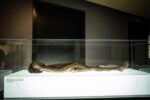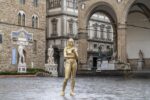Ange Leccia – Girls Ghosts and War
.jpg)
Galleria SIX è lieta di annunciare la mostra personale dell’artista corso Ange Leccia a cura di Elio Grazioli.
Comunicato stampa
Galleria SIX è lieta di annunciare la mostra personale dell'artista corso Ange Leccia a cura di Elio Grazioli.
Negli anni ’80 Leccia è diventato famoso per una delle operazioni artistiche più semplici eppure più fascinose, una sorta di readymade doppio. Infatti prendeva due esemplari di un oggetto, di varie dimensioni, anche molto grande, come le ruspe a Skulptur Projekte di Münster (1987) o due aerei o due petroliere (di cui è presente la versione fotografica in mostra), disposti uno di fronte o accanto all’altro. Era un’operazione radicale e significativa quant’altre mai, se si pensa che il raddoppiamento è la base di una certa idea di postmodernismo. Una delle mostre più importanti dell’arte americana del periodo si intitolò proprio Art and his double (1986). La versione di Leccia era più limpida di quelle americane e al tempo stesso inequivocabilmente poetica, sospesa e non dimostrativa com’era. Due oggetti identici, molto semplicemente, accostati, “arrangiati” dicono i francesi (ed era il titolo delle opere: Arrangement), come fossero uno il riflesso dell’altro, o come se si baciassero, come un incontro, ma anche come un fronteggiarsi, un affrontarsi. Perché il rapporto tra due è il più semplice ma anche il più paradigmatico: cosa accade tra i due? cosa li unisce e/o li separa? come stanno insieme? Ma il fatto che siano identici colora le domande di enigmaticità, come nel caso di due gemelli: qualcosa scorre tra i due, l’unità è l’insieme, non più il singolo, o altro ancora.
Negli anni ’90 Leccia passa a realizzare sempre più spesso video – ne aveva già girati prima, ma non ancora mostrati, e tornano montati ora. A volte ha accostato due proiezioni dello stesso video una accanto all’altra, ma via via Leccia passa dall’identico ad altre forme di rapporto e il video ora può anche essere da solo oppure vari in videoinstallazioni complesse. È come se invece di guardare ai due oggetti ora Leccia guardasse piuttosto allo spazio tra loro, quello in cui si toccano, pur rimanendo separati: lì accade qualcosa, qualcosa di speciale. È che il video è un medium particolare: la ripresa prima, con il suo faccia a faccia con il soggetto che si riprende, e la proiezione poi, con quel peculiare dispositivo che è lo schermo, sembrano contenere in partenza il due, il raddoppio e il rapporto. Ma Leccia va anche a caccia di soggetti che rendano più evidente questo nuovo e diverso raddoppiamento: l’esplosione, la scia della nave, il bagnasciuga, il lampo, la luce intermittente. Lì, in spazi-soglia, avvengono ogni sorta di mescolamento o di tensione, di turbolenze o di contatti, fucine di forme visive sempre cangianti.
(Elio Grazioli)
Ange Leccia è stato recentemente insignito "Chevalier de la Legion d' Honneur" dal ministro della cultura francese, Francoise Nyssen.
Il suo lavoro è stato esposto in importanti istituzioni pubbliche con mostre personali e collettive tra le quali
National Gallery of Iceland, Iceland,
Musée Bourdelle, Paris, France,
Museum of Fine Arts, Ho Chi Minh City, Vietnam,
Musée National Picasso La Guerre et la Paix, Vallauris, France,
Villa Médicis, Rome, Italy,
Contemporary Art Museum, Houston, TX, USA,
Museum Am Ostwall, Dortmund, Germany,
Musée de Grenoble, Grenoble, France
Tate Modern, London, U.K.,
Hiroshima City Museum of contemporary art, Hiroshima, Japan,
Biennale di Venezia, Venice, Italy,
Centre Georges Pompidou, Paris, France
‘Documenta 8’, Kassel, Germany ‘Skulptur Projecte’, Kunstverein Munster, Germany
Guggenheim museum, New York, NY, U.S.A.
Il suo lavoro si trova esposto in molte pubbliche collezioni tra le quali:
L'amour Louvre, Louvre Lens, France,
Fond National d’Art Contemporain, Paris, France,
Centre Georges Pompidou, Paris, France,
Le Musée d’Art Moderne de la Ville de Paris, Paris, France,
Fondation Cartier, Paris, France,
Guggenheim New York, NY, U.S.A.,
Seibu Museum Tokyo, Japan,
KIASMA, Musée d’Art Contemporain Helshinki, Finland,
MUKA Anvers, Belgium,
Musée de Nuremberg, Germany, The Progressive Collection, Cleveland, OH, U.S.A.
Galleria Six is pleased to announce a solo show by Corsican artist Ange Leccia curated by Elio Grazioli
In the '80s Leccia became famous for one of the simplest yet most fascinating artistic operations, a sort of double readymade. In fact, he took two copies of an object, of various sizes, even very large, such as the caterpillars at Skulptur Projekte in Münster (1987) or two airplanes or two oil tankers (of which a photographic version is on display), arranged one in front of the other (or next to it) . It was a radical and significant operation as never before, if one thinks that doubling is the basis of a certain idea of postmodernism. One of the most important exhibitions of American art of the period was titled Art and his double (1986). Leccia's version was more limpid than the American ones and at the same time unequivocally poetic, suspended and not demonstrative . Two identical objects, that were simply juxtaposed, "arranged" as the French say (and it was the title of the works: Arrangement), as if they were a reflection of one the other, or as if they were kissing, as an encounter, but also as a confrontation . Because a relationship between two parties is the simplest but also the most paradigmatic one: what happens between the two? What unites them and / or separates them? how are they together? But the fact that they are identical gives these questions sort of an enigmatic allure, as in the case of twins: something flows between the two, unity is the whole, no longer the single, or other.
In the '90s Leccia went on to make more and more videos - he had already shot them before, but never shown before, and they are back now. Sometimes he put two projections of the same video next to each other, but gradually Leccia goes from identical subjects to other forms of relationship . Therefore the video can now either be alone or inserted into complex video installations. It is as if instead of looking at the two objects now Leccia looks rather at the space between them, the one in which they touch, while remaining separate: something happens there, something special. Videos are a particular medium: the shooting first, with its face to face with the subject that is shot, and the projection then, with that peculiar device that is the screen, seem to contain the two from the begining , the doubling and the relationship. But Leccia also goes in search of subjects that make this new and different doubling clearer: the explosion, the wake of the ship, the shore, the lightning, the intermittent light. There, in threshold spaces, all sorts of mixing or tensions take place, of turbulences or contacts. All ever-changing visual forms.
(Elio Grazioli)
Cover: Concorde, arrangement 1985



